Are you choosing between Swift vs Flutter to build your iOS app?
Swift is a native language for developing iOS apps, and Flutter is a cross-platform framework for building applications on iOS, Android, web, and more from a single codebase.
Cross-platform frameworks like Flutter are everywhere — promising faster delivery and lower costs. For many teams, they’re the default choice. But in performance-critical iOS applications, that decision can quietly backfire.
Regularly ranked among the top custom app development companies on Clutch, our team at Volpis has spent years providing Swift development services to businesses worldwide. We’ve worked with logistics startups, SaaS platforms, and mobility companies where cross-platform fell short — introducing latency, sync failures, and subpar UX. The fix? A ground-up rebuild in native Swift.
While cross-platform tools have their place, native iOS development still delivers unmatched performance, UX fidelity, and hardware access. This isn’t theory — it’s what we’ve seen play out in real projects.
In this guide, we’ll break down the five specific situations where native app development with Swift programming language isn’t just better than cross-platform development with Flutter framework — it’s the only reliable choice. When your app involves real-time data, offline functionality, or tight hardware integration, this is the architectural clarity you need.
To build iOS apps that are robust and reliable, it’s important to hire a Swift developer with real-world experience, not just coding skills. If you’re looking for a team that understands the bigger picture behind successful app development, we are always here to answer all your questions and give honest advice. You can always connect with us via info@volpis.com
What we mean by native iOS app development
Native iOS app development means building your app using Swift (or sometimes Objective-C) directly on top of Apple’s SDKs — UIKit, SwiftUI, CoreLocation, CoreBluetooth, and others. You get full control over how the app interacts with the device — from rendering UI to managing memory, background tasks, sensors, and hardware APIs.
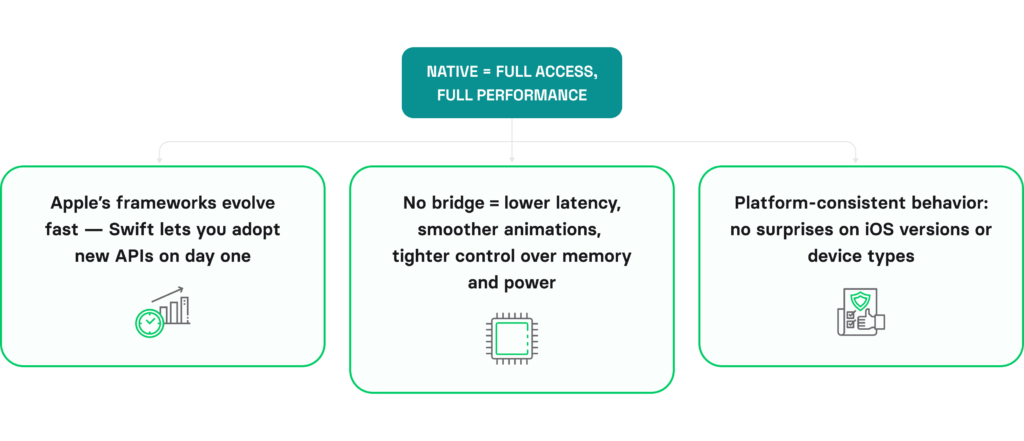
By contrast, cross-platform frameworks like Flutter abstract much of that away. You write code once, and the framework renders it on both iOS and Android using a bridge or custom rendering engine (Flutter). It sounds efficient — until you need performance, offline handling, or native behavior that these bridges can’t deliver cleanly.
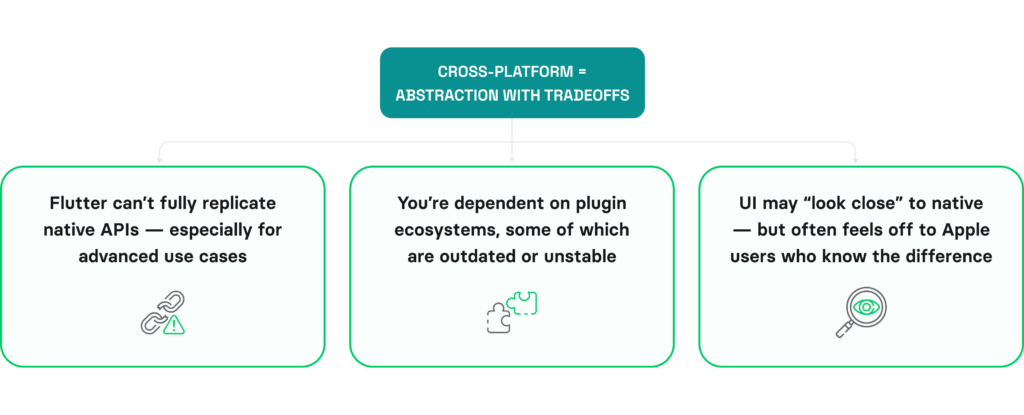
| Native = full access, full performance | Cross-platform = abstraction with tradeoffs |
| Apple’s frameworks evolve fast — Swift lets you adopt new APIs on day oneNo bridge = lower latency, smoother animations, and tighter control over memory and powerPlatform-consistent behavior: no surprises on iOS versions or device types | Flutter can’t fully replicate native APIs — especially for advanced use casesYou’re dependent on plugin ecosystems, some of which are outdated or unstableUI may “look close” to native — but often feels off to Apple users who know the difference |
If your iOS app is lightweight and doesn’t rely on advanced integrations, cross-platform frameworks like Flutter can be a solid and efficient choice.
Further reading: Top 9 traits to look for when hiring a Swift developer
When native app development with Swift clearly wins: 5 real-world scenarios
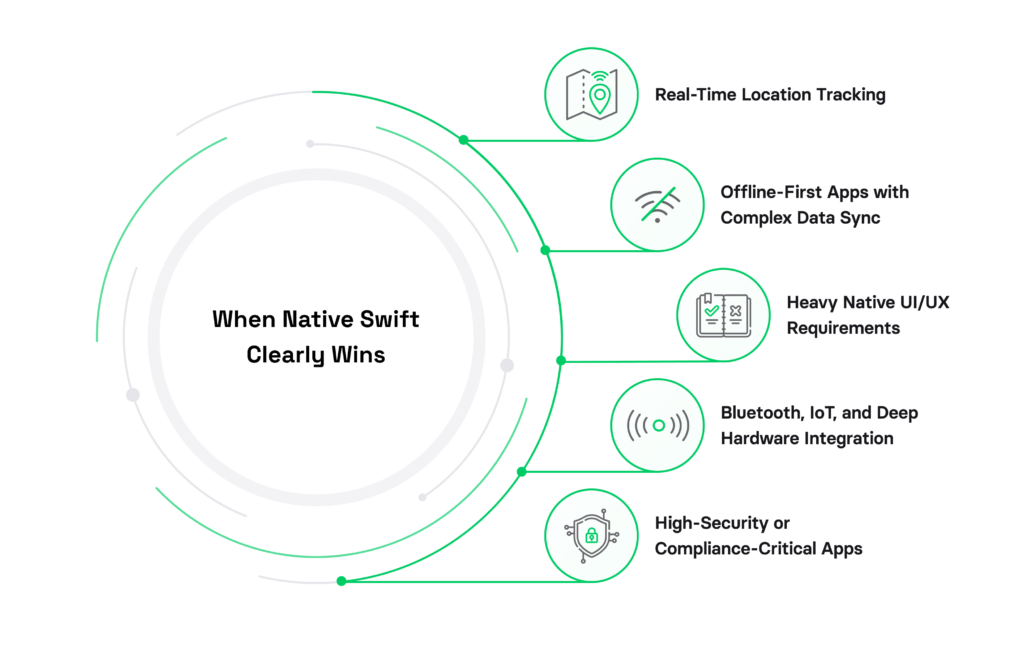
Let’s look at scenarios where native development delivers unmatched performance.
1. Real-time location tracking (fleet, navigation, logistics apps)
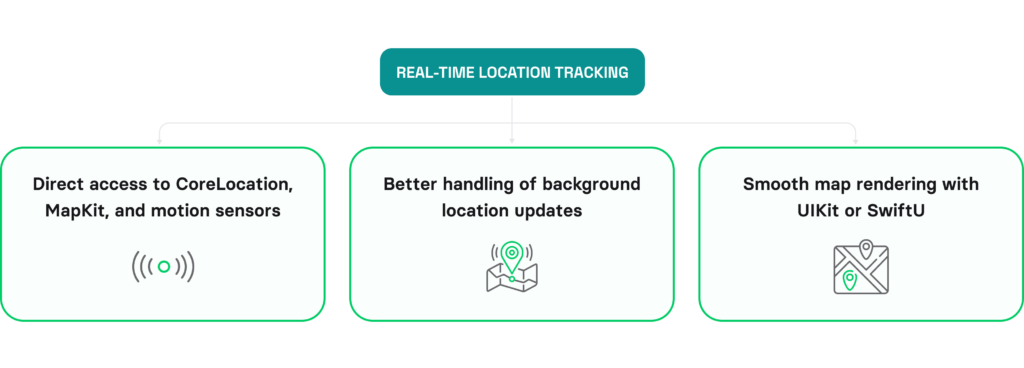
- Direct access to CoreLocation, MapKit, and motion sensors
- Better handling of background location updates
- Smooth map rendering with UIKit or SwiftUI
In contrast, cross-platform tools like Flutter often introduce delays in updates, broken tracking during low-signal transitions, and degraded performance — especially on mid-range devices. To avoid such problems, we used Swift when developing Rand One.
2. Offline-first apps with complex data sync
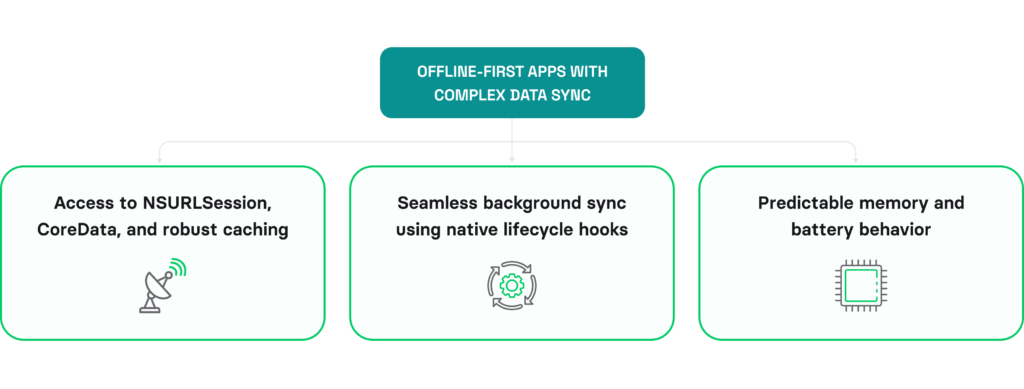
- Access to NSURLSession, CoreData, and robust caching
- Seamless background sync using native lifecycle hooks
- Predictable memory and battery behavior
On the contrary, cross-platform app development often fails silently here: missed updates, incomplete syncs, or battery drain.
3. Heavy native UI/UX requirements
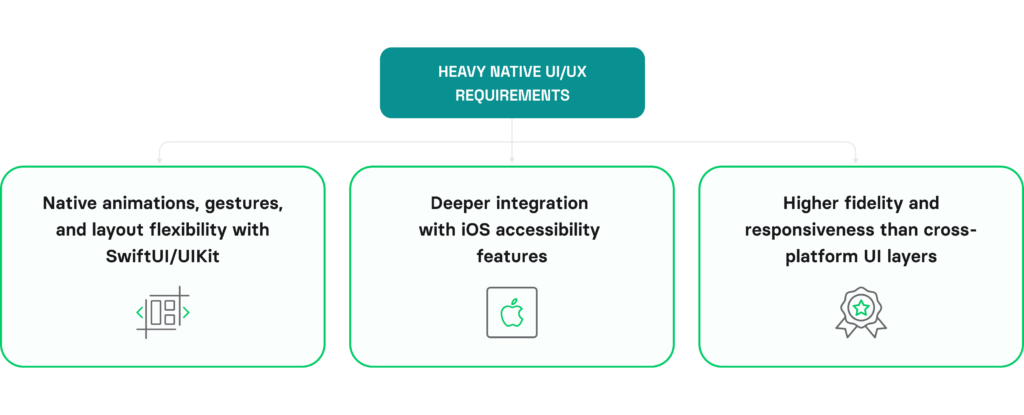
- Native animations, gestures, and layout flexibility with SwiftUI/UIKit
- Deeper integration with iOS accessibility features
- Higher fidelity and responsiveness than cross-platform UI layers
Cross-platform frameworks often add an abstraction layer over native components, which introduces delays. Users notice when interactions lag, animations glitch, or gestures aren’t native. That impacts retention.
4. Bluetooth, IoT, and deep hardware integration
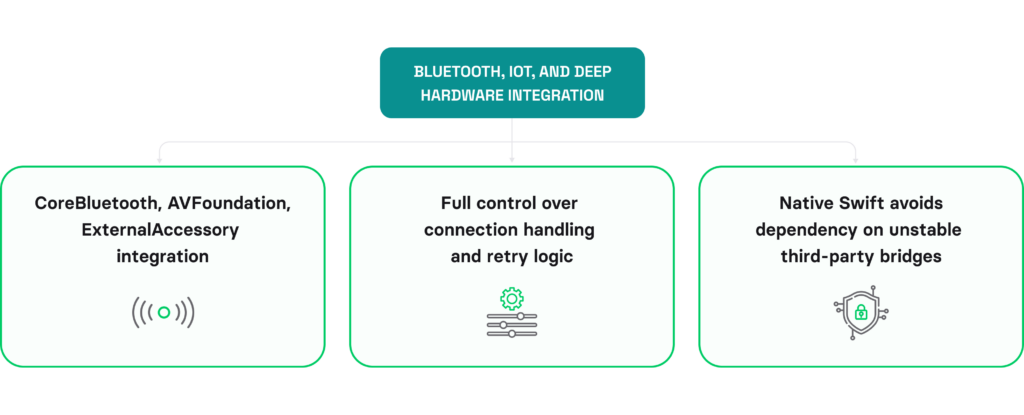
- CoreBluetooth, AVFoundation, ExternalAccessory integration
- Full control over connection handling and retry logic
- Native Swift avoids dependency on unstable third-party bridges
When your app controls hardware, reliability is non-negotiable. Cross-platform tools struggle because they rely on indirect access to iOS hardware.
5. High-security or compliance-critical apps
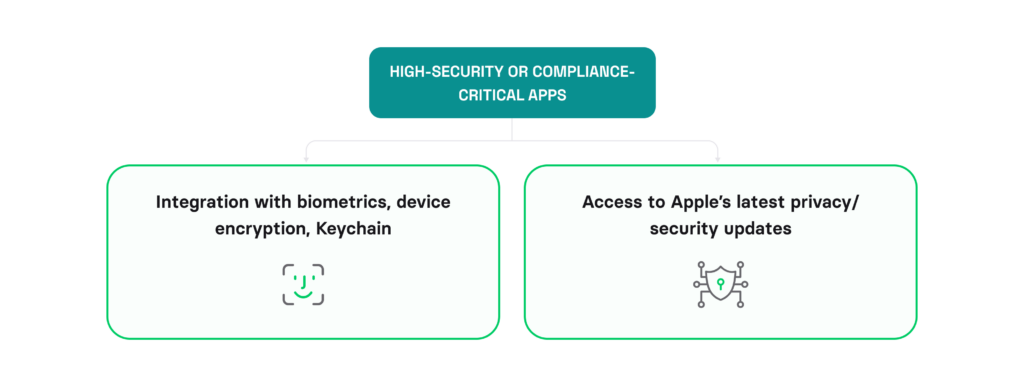
- Integration with biometrics, device encryption, and Keychain
- Access to Apple’s latest privacy/security updates
- Stable handling of permission flows and secure tasks
In high-compliance industries, cross-platform lag and plugin risks introduce unnecessary liability.
When cross-platform might be good enough
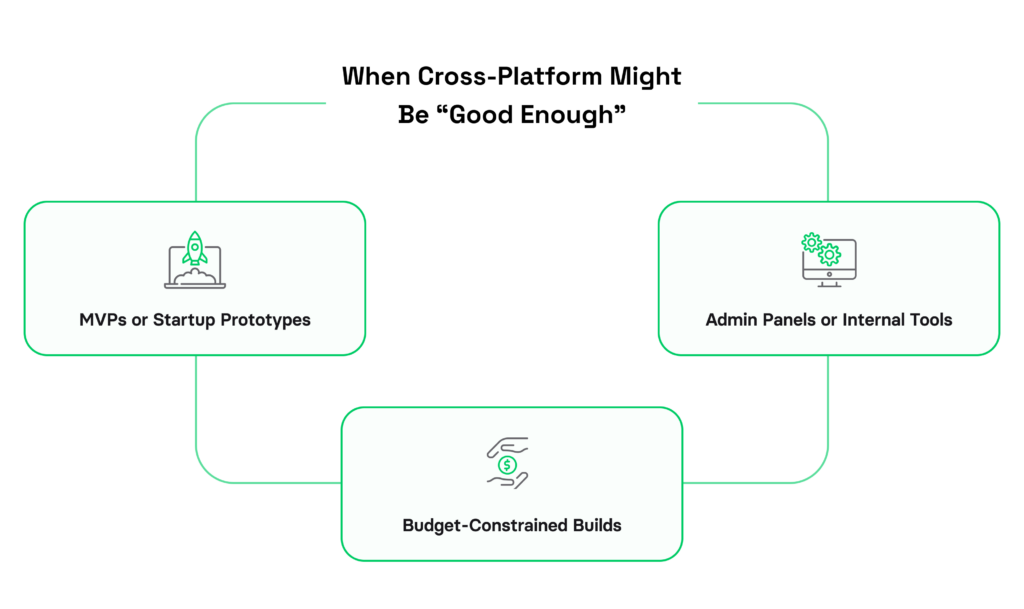
Not every app needs native architecture. Cross-platform frameworks can be the right call in:
MVPs or startup prototypes
- Prioritize speed over long-term optimization
- Polished UI and deep integrations can wait
Admin panels or internal tools
- Built for internal use with basic UX requirements
- Function over form — native polish not critical
Budget-constrained builds
- Cost-effective way to launch both iOS & Android quickly
- Acceptable for early-stage, low-risk products
If your app doesn’t rely on advanced device integrations or real-time performance, Flutter may offer an excellent balance of speed and cost-efficiency.
Flutter vs Swift: what to choose for your iOS app development project
Here’s a quick breakdown of both options to help you decide.
| Project requirement | Cross-platform (Flutter) | Native (Swift) |
| Basic UI, no hardware integration | ✅ | |
| Real-time location, live tracking | ✅ | |
| BLE / IoT / hardware integrations | ✅ | |
| Offline-first with robust background sync | ✅ | |
| High-performance UI, animations, native gestures | Possible, but fragile | ✅ |
| MVP, early-stage speed required | ✅ | |
| High-security or compliance-sensitive use cases | ✅ | |
| Scaling or infrastructure-intensive architecture | Often limited | ✅ |
When choosing iOS development tool, ask yourself:
- Will your iOS app run critical real-time logic on-device?
- Is user trust tied to performance or precision?
- Are you building a long-term product, not just an MVP?
If you answered “yes” to any of these — native is your safer bet.
Don’t choose your iOS app development tool based on trends
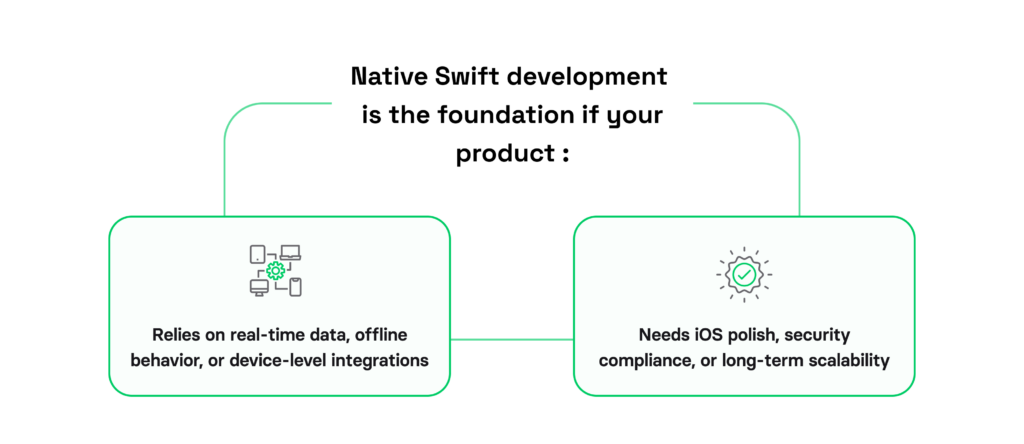
Cross-platform frameworks solve a lot of problems. But they don’t solve every problem.
If your product:
- Relies on real-time data, offline behavior, or device-level integrations
- Needs iOS polish, security compliance, or long-term scalability
— then native Swift development isn’t a luxury. It’s the foundation.
At Volpis, we’ve rebuilt apps that hit the wall with cross-platform development and scaled native apps in logistics, mobility, and IoT. We can help you choose the right stack and get the architecture right before you waste your budget. You can schedule a free consultation via info@volpis.com
Volpis perspective: what we have seen in the field
After years of hands-on experience in the industry, we’ve witnessed firsthand how the choice between native and cross-platform development can make or break a project.
1) Flutter-to-Native rebuild loop

- Product launches with Flutter
- Users report sync issues, performance bugs, UX problems
- Engineers hit plugin limitations
- Rewrite in Swift becomes necessary to scale
In some cases, the rebuild cost more than starting with native from day one.
2) Native from day one
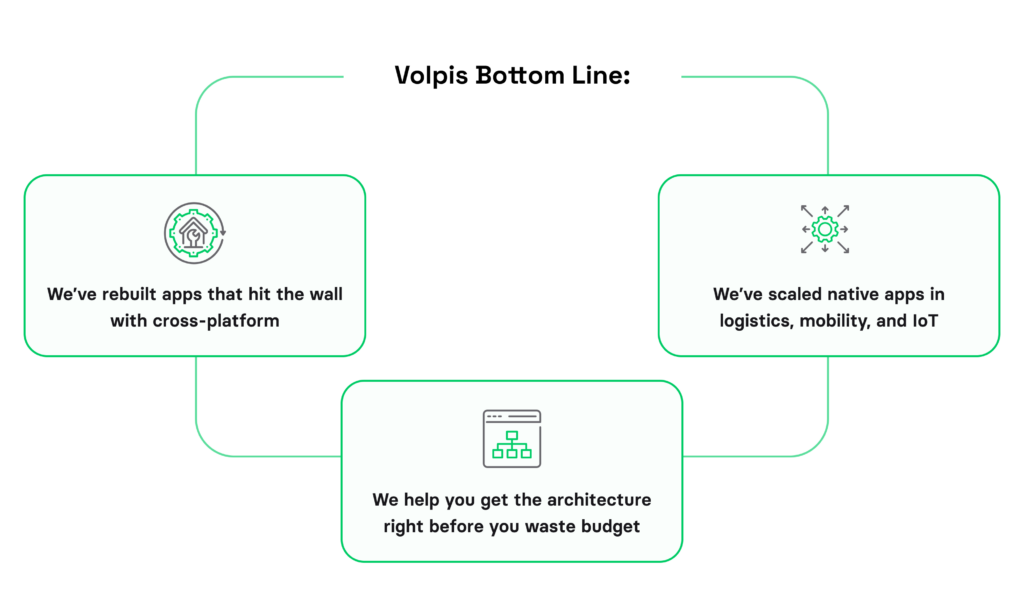
For BLE-based tools, offline-first fleet apps, or any use case needing uptime and integration depth, Swift delivers the resilience and control cross-platform can’t match.
We don’t just write Swift. We know when it matters.
How developers at Volpis use Swift to create custom applications with over a million downloads
The Volpis team has been leveraging the power of Swift to build robust applications and assist business owners in achieving unparalleled milestones. One recent example is the Holy Quran app.
The Holy Quran is a popular non-profit application for Android and iOS. The app’s main objective is to provide accurate knowledge about Islam and serve as a platform for studying the Quran. A few years ago, the app needed significant updates.
Our team focused on performance optimization, UI/UX improvements, and backend maintenance.
The app has become a trusted resource for the Muslim community and those interested in Islam. Today, the app has a 4.8-star rating, over 11,000 reviews and has surpassed 1 million downloads.
Hire iOS developers you can count on
Consistently recognized as one of the Top Custom Software Development Companies on Clutch, our team at Volpis has rich experience in custom iOS app development for startups and enterprises across diverse industries.
Read more reviews from our valuable customers on Clutch
We invite you to explore our portfolio for a detailed look at the innovative mobile applications we have developed for our clients.
If you need to hire a Swift app developer with exceptional technical expertise, you can reach out to us via info@volpis.com with any questions or to explore how we can be part of your journey.
Hire experienced and reliable Swift developers today
We would be happy to answer all your questions and help make your project a total win!
FAQ
Can I start with Flutter and switch to Swift later if needed? And vice versa?
You can — but switching usually means a full rewrite. Flutter framework and Swift programming language use entirely different architectures, so code can’t be reused. If you’re building something simple short-term, it might work. But if you expect to scale or need native performance later, it’s better to choose the right stack from the start.
Does Flutter save two times the development time compared to native?
No, it probably doesn’t — especially for complex apps. In practice, Flutter typically saves around 30–40% of development time when targeting both iOS and Android. But that gain shrinks fast if your app requires advanced native features, real-time performance, or long-term maintenance.
Can I create a companion Apple Watch experience from my iOS Flutter app?
Yes, but not entirely in Flutter. You’ll need to build the Apple Watch companion in native Swift using Xcode and connect it to your Flutter iOS app via platform channels and Apple’s WatchConnectivity framework. Flutter handles the iPhone app UI, while the watch interface and logic are built natively.

Kostya Khuta, the CEO of Volpis, is an expert in crafting custom software solutions for the Fleet Management, Logistics, and Transportation industry. With over 8 years of experience, he leads the way in delivering innovative and tailored solutions to meet industry-specific needs.





